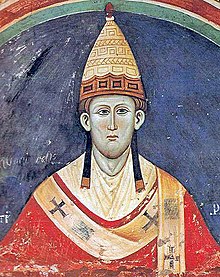Pallium
The pallium (derived from the Roman pallium or palla, a woolen cloak; pl.: pallia or palliums) is an ecclesiastical vestment in the Catholic Church, originally peculiar to the pope, but for many centuries bestowed by him on metropolitans and primates as a symbol of the jurisdiction delegated to them by the Holy See. In that context it has remained connected to the papacy.[1]
The pallium, in its present Western form, is a narrow band, “three fingers broad”, woven of white lamb’s wool from sheep raised by Trappist monks, with a loop in the centre resting on the shoulders over the chasuble and two dependent lappets, before and behind; so that when seen from front or back the ornament resembles the letter Y. It is decorated with six black crosses, one on each tail and four on the loop, is doubled on the left shoulder and sometimes is garnished, back and front, with three jeweled gold pins. The two latter characteristics seem to be survivals of the time when the Roman pallium was a simple scarf doubled and pinned on the left shoulder.
In origin, the pallium and the omophor are the same vestment. The omophor is a wide band of cloth, much larger than the modern pallium, worn by all Eastern Orthodox bishops and Eastern Catholic bishops of the Byzantine Rite. The theory that explains its origin in connection with the figure of the Good Shepherd carrying the lamb on his shoulders, so common in early Christian art, may be an explanation a posteriori. The ceremonial connected with the preparation of the pallium and its bestowal upon the pope at his coronation, however, suggests some such symbolism. The lambs whose wool is destined for the making of the pallia are solemnly presented at the altar by the nuns of the convent of Saint Agnes. The Benedictine nuns of Santa Cecilia in Trastevere later weave the lambs’ wool into pallia.













































































